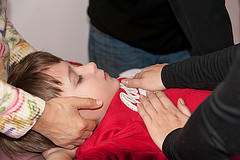Study of Qigong Massage on Elementary School-Aged Children with Autism Shows Promising Results
September 8, 2016
By Mark Schalock and Louisa Silva
 As has been recently acknowledged, almost all young children with autism
have abnormal responses to touch. That is, they are overly sensitive or under responsive
to touch or pain. Since
touch is very important to a child’s development it has been suggested that these
tactile abnormalities present a barrier that interferes with typical development.
As has been recently acknowledged, almost all young children with autism
have abnormal responses to touch. That is, they are overly sensitive or under responsive
to touch or pain. Since
touch is very important to a child’s development it has been suggested that these
tactile abnormalities present a barrier that interferes with typical development. Several randomized control trials conducted by a team of medical professionals
and The Research Institute staff with preschool children with Autism Spectrum
Disorder (ASD) have found that a “tactile stimulation protocol,” Qigong Sensory
Treatment (QST) massage for autism, has been successful in normalizing
responses to touch and decreasing the
severity of autism. For example, by the end of two years of treatment touch had
normalized by 73% and overall severity of autism has been reduced by 44% in
children ages 3-5.
But what about older children?
This study for the first time seeks to determine whether the massage protocol is also effective with older children, ages 6-11. Previous research hasn’t determined whether the window of opportunity for treating this “tactile impairment” closes after the age of six. This article reports the results of a small randomized controlled study evaluating treatment efficacy of QST in 35 children with ASD ages 6 to 11.
The older children in this study experienced improvements in their response to touch and reductions in the overall severity of autism similar to younger children. At the end of one year of treatment the older children showed an 85% normalization of touch. In addition, when we compared one year outcome data for 6- to 11-year-olds with one year outcome data in 2- to 6-year-olds we found similar reductions of autistic behavior (51% and 35% normalization) and autism severity (21% and 27% normalization).
Window of opportunity
These results suggest the window of opportunity for treating tactile impairment in 6- to 11-year-old children with ASD remains open and that treatment can reduce the severity of autism in older children.
Click below to read the full research article.
QST massage for 6-12 year olds with Autism Spectrum Disorder: An extension study.
Louisa M.T. Silva, MD, MPH, Visiting Professor (Corresponding Author) - The Research Institute, Western Oregon University, USA
Mark Schalock - The Research Institute, Western Oregon University
Kristen Gabrielsen, MPH - Consultant for The Research Institute, Western Oregon University
Gretchen Horton-Dunbar - Sikhara Group
(Photo at top of child receiving massage by Tyra Murray of Grace Portraits)
Recent News Items
Three More Years for Campus Against Sexual Assault Program Nov 9, 2016
Study of Qigong Massage on Elementary School-Aged Children with Autism Shows Promising Results Sep 8, 2016
Doris Cancel-Tirado Named Abby's House Woman of the Year Jun 4, 2016
Western's Sexual Assault Prevention Featured in the Statesman Journal Mar 16, 2016
Life Experiences Inspire Crucial Research into Health Disparities for Latino Children Jan 29, 2016


